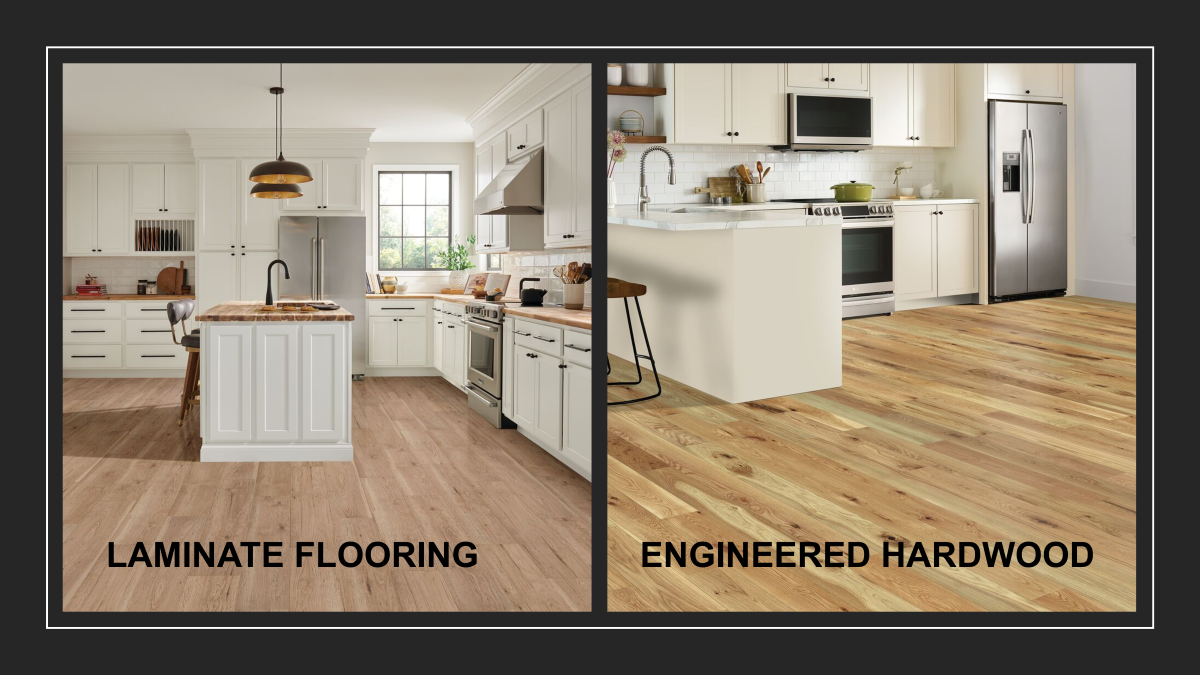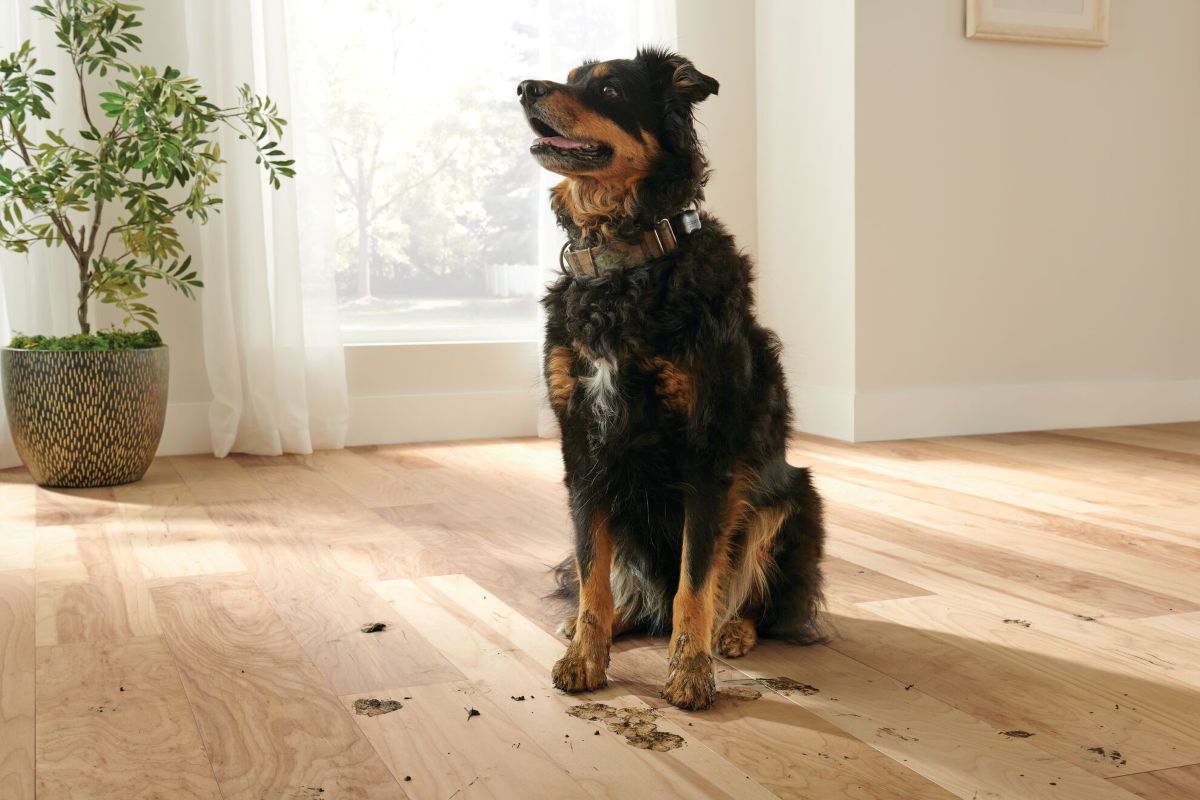Laminate vs. Engineered Hardwood – How To Decide
By Bruce Product Expert, Published August 22, 2025
You love wood flooring, but have some concerns about whether it will work in your space. Maybe you have some moisture concerns. Or perhaps you’re on a tight budget.
No matter. You can select from plenty of wood-look flooring options.
Two popular selections today include laminate and engineered hardwood. Both offer unique advantages depending on your space, lifestyle, and budget. This guide breaks it all down, so you can choose the best flooring product for your home with confidence.

What’s the Difference Between Laminate and Engineered Hardwood?
To understand the fundamental difference between the two, it’s helpful to understand their construction. It impacts their performance and longevity.
Laminate Flooring Construction
Laminate flooring is 100% synthetic. It includes a high-density core layer, topped with an image layer. The top layer replicates the appearance of wood sealed with a protective wear layer. It adds a high degree of scratch and resistance to the flooring.
Owing to its materials and construction, many laminate floors are waterproof. For example, Bruce® offers TimberTru™ laminate flooring that’s waterproof from top to bottom against moisture.
Engineered Hardwood Construction
Engineered hardwood flooring, on the other hand, incorporates multiple layers of wood. A real hardwood layer sits on top. A plywood or high-density fiber (HDF) core rests underneath that for improved stability.
This construction makes it more stable than solid hardwood flooring. As a result, you can use engineered hardwoods in areas prone to moisture, such as basements. Don’t confuse that, though, with being waterproof. The flooring is only water-resistant.
For truly waterproof performance, look to a product like Hydropel™ engineered hardwood flooring. This Bruce offering features six water protection dimensions to keep the floors safe from water damage.
Pros and Cons At a Glance
Understanding their construction and its impact, let’s jump to a quick side-by-side comparison. This chart highlights the core differences, allowing you to see how each flooring type performs in key areas. We’ll get into more specifics after the chart.
| Feature | Laminate | Engineered Hardwood |
| Scratch Resistant | Highly resistant to scratches | More prone to scratches |
| Water Resistant | Some styles are water-resistant | More sensitive to moisture |
| Looks Like Real Wood | Very close; depends on image layer | It is real wood |
| Wear Layer | Tough melamine coating | Real wood veneer |
| Top Layer Thickness | Not refinished | It can sometimes be refinished |
| Installation | Easy DIY with laminate installation | May require glue or nails |
| High Traffic Areas | Very durable | Good, but it can show wear and tear |
| Price | Budget-friendly | Higher upfront cost |
Can You Tell the Difference Between Engineered Wood and Laminate?
Looks matter, especially when you’re investing in flooring. Modern laminate is surprisingly convincing, but there are subtle differences that might influence your decision.
Today’s high-quality laminates are nearly indistinguishable from real wood. That’s thanks to advanced image layer technology and realistic wood species patterns. That said:
- Laminate tends to repeat patterns over large areas. Additionally, laminate can’t replicate the texture of hardwood, particularly with hand-scraped or wire-brushed finishes.
- Engineered hardwood uses real hardwood for its surface, which adds more depth and texture, ensuring that no two planks are identical.
From a distance, both look great. Up close, engineered hardwood feels more authentic underfoot and gives that classic solid wood feel.
Laminate vs. Engineered Hardwood Costs
Budget is often one of the more significant factors when deciding between laminate and engineered wood flooring. Here’s how they compare in terms of pricing.
- Laminate generally ranges from $1 to $3 per square foot for materials.
- Engineered hardwood typically starts around $3 and can range up to $10 per square foot.
- Laminate generally installs as a floating floor, making it a reasonably simple DIY project. You can nail, glue, or float engineered hardwood, making the installation process somewhat more involved.
According to HomeAdvisor, the average installation cost for engineered hardwood ranges from $4 to $8 per square foot. The average price for installing laminate, on the other hand, typically costs $2 to $4 per square foot.

Pets, Kids, and Life: Which Holds Up Better?
Your floor takes a beating every day. Whether it’s muddy paw prints, toy trucks, or the occasional dropped drink, you need flooring that can handle the real world. Here’s how laminate and engineered hardwood perform under pressure.
If you have dogs, cats, or a house full of kids, durability matters.
Laminate’s tough wear layer makes it highly scratch-resistant, making it ideal for high-traffic areas. So if you have a rambunctious dog, you’ll see fewer blemishes on your floors.
When it comes to engineered hardwood, keep in mind that the top layer is real wood. That makes it susceptible to scratches, although perhaps less so than solid hardwoods.
If you’re concerned about water resistance, laminate typically handles spills and accidents more effectively. Just make sure to choose a style rated for moisture-prone spaces.
For the best of both worlds, consider densified engineered hardwood. Dogwood® from Bruce features hardened wood that delivers four times the scratch resistance and six times the dent resistance of standard hardwoods. It can handle everyday wear and tear from kids and pets.
Maintenance and Longevity
Nobody wants to spend weekends scrubbing floors or worrying about refinishing. Here’s what to expect regarding care, cleaning, and the lifespan of each floor.
Laminate is easy to clean using a damp mop. However, don’t oversaturate the flooring. Generally, laminate flooring lasts 15-25 years, although TimberTru offers a lifetime residential warranty. Regular maintenance makes it a practical choice for those seeking low-maintenance flooring products.
Engineered hardwood requires more careful maintenance. But it can last 20-30 years.
But the story doesn’t end there. Depending on the thickness of the top layer, you can sand and refinish engineered wood floors. In many cases, you can double their lifespan.
Choosing Between Laminate and Engineered Hardwood
Use this quick guide to match the floor to your lifestyle and priorities.
Choose laminate if:
- You need something affordable and scratch-resistant
- You’re installing flooring yourself
- You need your floors to be waterproof
Choose engineered hardwood if:
- You want the feel and prestige of real wood
- You’re okay spending more upfront for long-term value
- You plan to live in your home for many years
Bruce® is Your Go-To Source for Wood and Wood-Look Flooring
Whether you’re leaning toward laminate or engineered wood flooring, Bruce offers stylish, durable options to match your lifestyle.
Its laminate flooring options feature hickory, oak, and maple looks in nearly 30 color selections. Engineered hardwood options are even more impressive with ash, birch, cherry, hickory, maple, oak, walnut, and pine. You can also choose from various finishes, including distressed, wire-brushed, and hand-scraped styles.
Explore Bruce’s collections today to find the right fit for your space. Find a Bruce retailer near you.
